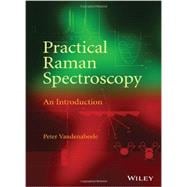
Note: Supplemental materials are not guaranteed with Rental or Used book purchases.
Purchase Benefits
What is included with this book?
Acknowledgements xv
Acronyms, Abbreviations and Symbols xvii
Introduction to Raman spectroscopy xix
1 Theoretical Aspects 1
1.1 Classical Approach 1
1.2 Selection Rule 7
1.3 Energy Levels and Group Frequencies 13
1.4 Raman Intensity 19
1.5 Raman Bandwidth 35
1.6 The General Appearance of a Raman Spectrum 37
1.7 Summary 38
Intermezzo 1.1 The Harmonic Oscillator and the Position of the Vibrational Energy Levels 6
Intermezzo 1.2 The Anharmonic Oscillator and the Position of Vibrational Energy Levels 11
Intermezzo 1.3 Raman Intensity Annotations 30
2 Interferences and Side-effects 39
2.1 Absorption 40
2.2 Fluorescence 40
2.3 Thermal Effects, Photodecomposition and Laser Ablation 43
2.4 Ambient Light and Background Radiation 44
2.5 Summary 44
3 Enhancement of the Raman Signal 47
3.1 Resonance Raman (RR) Spectroscopy 48
3.2 Surface-Enhanced Raman Spectroscopy (SERS) 48
3.2.1 Working Principle of SERS 49
(a) Chemical Enhancement 49
(b) Field Enhancement 51
3.2.2 Preparation of SERS Substrates 53
(a) Colloids 54
(b) Sputtering 55
(c) Electrochemical Production 55
(d) Etching 56
3.2.3 SERS Active Molecules 56
3.2.4 Advantages and Disadvantages of SERS 57
3.3 Summary 59
Intermezzo 3.1 The Analysis of Organic Dyes by SERS 58
4 Raman Instrumentation 61
4.1 Lasers 62
4.1.1 Classification According to Safety Category 64
4.1.2 The Operating Principle of the Laser 65
4.1.3 Lasers for Raman Spectroscopy 71
4.2 Detectors 74
4.2.1 Single-Channel Detectors 75
4.2.2 Multi-Channel Detectors 76
4.2.3 Charge-Coupled Device (CCD) Detectors 76
4.2.4 Semi-conductor Detectors 80
4.3 Filters 81
4.4 Dispersion Systems 83
4.4.1 Systems Based on Diffraction of Light 83
4.4.2 Fourier-Transform (FT-) Systems 86
4.5 Components for Transportation of Light 88
4.6 Sample Chambers and Measurement Probes 91
4.7 Noise in Raman Spectroscopy 95
4.7.1 Noise Originating from the Sample: σs 96
4.7.2 Noise Originating from the Raman Instrument: σi 98
4.7.3 Noise Originating from the Signal Processing: σp 99
4.8 Summary 99
Intermezzo 4.1 The Helium-Neon laser 69
5 Raman Spectroscopy in Daily Lab-life 101
5.1 Calibration of a Raman Spectrometer 102
5.1.1 X-Axis Calibration 102
5.1.2 Y-Axis Calibration 105
5.2 Raman Spectral Post-processing 108
5.2.1 Digital Filters 109
5.2.2 Scaling 110
5.2.3 Deconvolution 112
5.2.4 Baseline Corrections 113
5.3 Interpretation of Raman Spectra of Organic Molecules 116
5.3.1 Raman Spectra of Alkanes and Cycloalkanes 120
5.3.2 Raman Spectra of Alkenes and Cycloalkenes 125
5.3.3 Raman Spectra of Aromates 129
5.4 Interpretation of Raman Spectra of Inorganic Molecules 131
5.5 Quantitative Aspects of Raman Spectroscopy 134
5.6 Fingerprinting and Spectral Searching Algorithms 137
5.7 Raman Mapping and Imaging 141
5.8 Combination with Other Techniques 145
5.9 Summary 147
Intermezzo 5.1 Micro-Raman Spectroscopy in Microbiology 107
Intermezzo 5.2 Raman Spectroscopy in a Forensics Laboratory 117
Intermezzo 5.3 Pigment Analysis with Raman Spectroscopy 132
Intermezzo 5.4 Detection of Counterfeit Medicines with Raman Spectroscopy 136
Intermezzo 5.5 Exobiology: Raman Spectroscopy Helps the Search for Life on Mars 139
Intermezzo 5.6 Direct Analysis of Precious Art Objects 144
Responses to Questions 149
Bibliography 153
Glossary of Terms 155
Index 157
The New copy of this book will include any supplemental materials advertised. Please check the title of the book to determine if it should include any access cards, study guides, lab manuals, CDs, etc.
The Used, Rental and eBook copies of this book are not guaranteed to include any supplemental materials. Typically, only the book itself is included. This is true even if the title states it includes any access cards, study guides, lab manuals, CDs, etc.